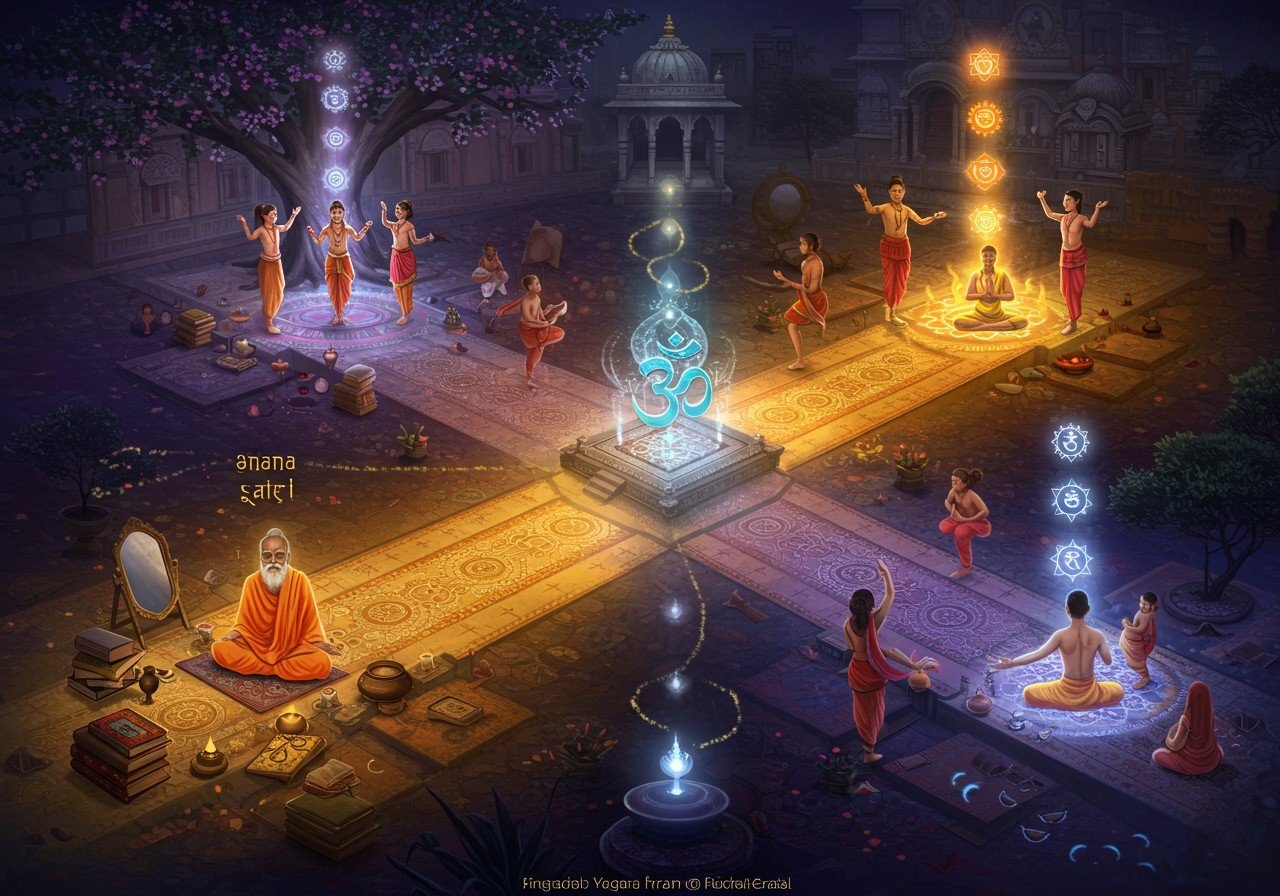
Embarking on a journey to understand the four primary paths of Yoga is an enlightening experience. These paths—Jnana, Bhakti, Karma, and Raja Yoga—rooted in Hindu philosophy, cater to diverse facets of human nature and spirituality. Gaining insights into their unique characteristics empowers you to integrate these ancient practices into your modern life. By appreciating tradition and spirituality, you can discover profound meaning and relevance in these paths.
Jnana Yoga: The Path of Knowledge
Jnana Yoga emphasizes knowledge and wisdom as the path to spiritual awakening. Practitioners engage in self-inquiry, known as Viveka, to discern reality from illusion (Maya). This path involves deep scriptural study, reflection, and meditation to comprehend the self and the universe. A Guru-disciple relationship is often essential, providing guidance and helping seekers overcome obstacles such as ego and intellectual arrogance.
Bhakti Yoga: The Path of Devotion
Bhakti Yoga centers around love and devotion directed towards a personal deity. Practices like chanting, singing hymns, and performing rituals cultivate a deep emotional bond with the divine. Surrender (Bhakti) plays a crucial role in transcending the ego and attaining liberation. Bhakti Yoga manifests diversely across various sects and communities in India, with communal worship serving to strengthen devotion and practice. Dive deeper into Bhakti Yoga with our comprehensive guide.
Karma Yoga: The Path of Selfless Action
Karma Yoga focuses on performing duties without attachment to outcomes. This principle, known as Nishkama Karma, involves selfless service, which purifies the mind and diminishes selfish desires. Practically, Karma Yoga integrates into daily life through fulfilling family responsibilities and contributing to society. The teachings of the Bhagavad Gita heavily influence this approach to a balanced and ethical life. The path’s challenges include cultivating detachment and maintaining equanimity amidst success and failure. Embrace the principles of Karma Yoga with our beautiful Bel malas, perfect for mindful meditation.
Raja Yoga: The Path of Meditation and Control
Raja Yoga, also known as the “Royal Path,” centers on meditation and mastering the mind. It adheres to the eight limbs of Yoga (Ashtanga Yoga) as outlined by Patanjali: Yama, Niyama, Asana, Pranayama, Pratyahara, Dharana, Dhyana, and Samadhi. Meditation and breath control are essential for achieving mental clarity and tranquility. Ethical living and discipline form the foundation of Raja Yoga practice. The challenges inherent in this path include maintaining consistent meditation practice and overcoming mental distractions. Enhance your Raja Yoga practice with our exquisite Shiva Lingams to create a sacred space for your meditation.
Comparing the Four Paths: Jnana, Bhakti, Karma, and Raja Yoga
Each path of Yoga offers a distinct approach to spiritual growth and self-realization.
- Jnana Yoga appeals to those seeking wisdom through introspection and self-discovery. It encourages deep contemplation and study to understand the true nature of reality and oneself.
- Bhakti Yoga resonates with individuals drawn to expressing love and devotion to a personal god. It offers a path to connect with the divine through prayer, chanting, and rituals, fostering a sense of belonging and surrender. Explore our Radha Krishna idols to enhance your Bhakti practice.
- Karma Yoga suits those who find purpose in selfless action and service. It provides a framework for living ethically and contributing to the world, emphasizing detachment from outcomes and focusing on fulfilling one’s duties.
- Raja Yoga attracts seekers of inner peace and mental clarity through meditation and self-discipline. It offers a systematic approach to controlling the mind, leading to greater self-awareness and liberation from illusions. Deepen your meditation practice with our Tulsi malas.
While distinct, these paths share a common goal: unity with the divine. Each addresses mental impurities, such as selfishness (Mala), a restless mind (Vikshepa), and ignorance of our True Self (Avavana). Choosing a path is a personal journey guided by inner inclinations and aspirations.
Embracing Your Path
Within the rich tapestry of Yoga, each path—Jnana, Bhakti, Karma, and Raja—offers a unique route to spiritual fulfillment. These timeless teachings guide us toward self-understanding and our place within the universe. By honoring these traditions, you can find a path that resonates with your heart and mind.
There’s no single “right” path; each leads towards the same ultimate truth. Whether you seek knowledge, devotion, selfless service, or inner peace, let your intuition and experiences be your guide. Embrace the practice that calls to you, and allow it to shape your life’s journey. Approached with respect and sincerity, these ancient paths can bring profound joy and a deep connection to the divine, enriching both your personal and spiritual life. Learn more about planning your spiritual retreat with our Ashram Stay Guide.


